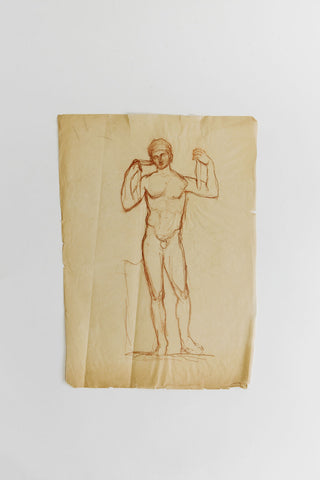The Statue | Juliette Stievenart-de Reul
- Unit price
- /per
About the Collection:
19th-century French School pencil and crayon drawing on paper from a portfolio belonging to Juliette Stievenart-de Reul.
About the Artist:
Juliette Stievenart-de Reul was a French and Belgian avant-garde artist, born on July 14, 1872. She was the daughter of a Belgian geologist and novelist. Gifted in drawing from a very young age and encouraged by her family, she was admitted to the Ecole des Beaux-Arts in Paris.
During the 1890s, Stievenart-de Reul moved to Montmartre and frequented the neighborhood's cafés and workshops, mingling with other emerging artists such as Henri de Toulouse-Lautrec and Edgar Degas.
A match for her environment and Montmartre at the time, she was full of energy and explored avant-garde concepts through oil painting, drawing, watercolor, and pastels. Her technique is characterized by a fusion of classical and modern influences, with a particular affinity for Impressionism. She experimented with new compositions and perspectives, and ventured into various representational techniques, ranging from lines and geometric shapes to expressive distortions.
Stievenart-de Reul stood out as a rarity of her time by her gender and her mastery of contrasts. She often utilized light and shadow to create striking visual effects, both in her pencil sketches and also in her oil paintings.
In 1889, she joined the L'École de Wissant, a hub of sustainable artistic creation located in a small fishing village in the north of France. There, she sought the light and was drawn to the red roofed houses. It was there that she met the painter Fernand Stiévenart (1872-1922), her future husband and artistic partner.
In the 1900's, Stievenart-de Reul became actively involved in political and social movements. She joined feminist groups and participated in protests for women's rights and gender equality. This political commitment sometimes found its reflection in her art.
Throughout her career, Stievenart-de Reul exhibited her works in prestigious galleries in Paris, London, and New York. Her paintings were known for their masterful technique, vibrant colors, and, above all, their constant pursuit of conveying deep emotions.
Despite these accomplishments, Stievenart-de Reul's career was always more discreet than her husband's. Fortunately, she was encouraged by her mentor Virginie Demont-Breton (daughter of Jules Breton, inspiration to Van Gogh) at a time when women were little recognized in the art world. Fernand Stiévenart and Juliette de Reul settled in Uccle in the southwest of Brussels in 1913 where they died respectively in 1922 (January 22) and 1925. They left behind an artistic contribution that remained largely hidden for more than a century.
Adding product to your cart


